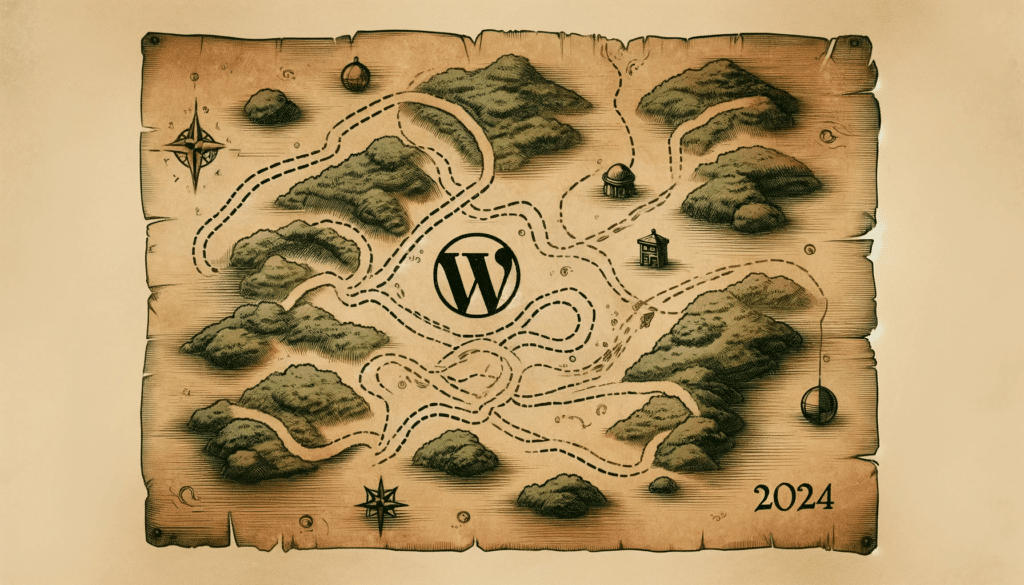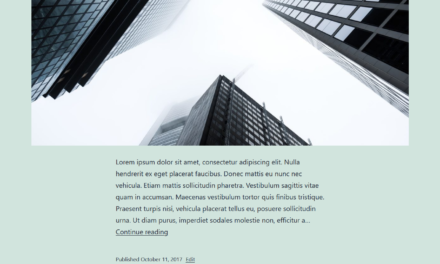The year is coming to an end, it’s time to look ahead. Besides guessing what the web design trends for 2024 are going to be, it also makes sense to see what we can expect from WordPress. Especially since Executive Director Josepha Haden Chomphosy recently published a proposed WordPress roadmap for 2024.
In this post, we want to look at what it spells for the WordPress platform and community for the new year. We will examine the planned releases, features we can expect, issues still to be solved, and what it all means in the bigger context. That way, you can ready yourself, your website, and your business for what is to come.
What’s on the Roadmap for WordPress in 2024?

As a first step, let’s go over the preliminary plans for what the WordPress developers are aiming to accomplish in 2024.
Three Major Releases
The first thing that stands out is that the planning schedule includes three major releases and their preliminary dates and timelines:
- WordPress 6.5 (March 26)
- WordPress 6.6 (July 16)
- WordPress 6.7 (November 5)
Those deadlines are not set in stone, however, they do form a rough orientation for those involved with producing the respective releases. The deadlines try to work around big WordPress events, like WordCamp Europe and WordCamp Asia, as well as major holidays.
At this point, we don’t exactly know what the releases will be about. While there is an official page for WordPress 6.5, at the time of this writing it’s still empty. No contributors, leads, or other people of the team have been announced. However, annezazu is already collecting features for the new version.

What is clear is that 2024 is the year we are moving into Phase 3 of the Gutenberg project. Phase 2 focused on site customization, which has been mainly finished with the implementation of the Site Editor. Earlier features, like the block editor, will still see updates and improvements but they will no longer be the main focal point.
The coming phase is going to be about collaboration and 2024 will go whole hog on that front. One exception: version 6.6., which will be “held specifically for maintenance and general polish of the software (as was wished for earlier this year).” I am not entirely sure what that means yet but we will try to find out.
Feedback From the Community
The proposal was posted on WordPress.org in order to collect feedback from other community members. At the time of this writing, the main suggestions have been this:
- Include raising the minimum PHP version in the plans
- Swap focuses for 6.5 and 6.6, especially since there are still some features outstanding from earlier releases, in particular typography management
- Implement some way for community members to vote on features or somehow have a say in what the versions should include
- Consider going from three to four major releases per year
- Move the November release to avoid clashing with US elections
The discussion is still ongoing and you can chime in with your opinion. We also have first volunteers for the WordPress 6.5 release team.
What Does This Mean for WordPress Users?
So far the rough outline. What’s most interesting for WordPress users is, of course, what is on the agenda for these releases? What can we expect to see in the WordPress platform in terms of new features and functionality in 2024? And what else should we get ready for? Let’s talk about that now.
Leftovers From Phase 2
Just because the focus is shifting over to Gutenberg Phase 3, that doesn’t mean that’s all we’ll hear about in the WordPress 2024 roadmap. Development will also continue on other parts of WordPress including features from Phase 2.
Specifically, one of the next big changes will be typography management. It was supposed to come out in November 2023 but got punted from WordPress 6.4 because it wasn’t ready. Specifically, the feature will add a font library to WordPress where users can choose the typefaces they want similar to Google Fonts.
Active font faces then become available in the editor for theme and content styling. This also works with local fonts and the goal is to create the possibility for third-party plugins to add their own as well. For that purpose, the developers are implementing a Fonts API and WordPress will automatically add the necessary @font-face markup to allow your custom fonts to appear on the page.
Real-Time Collaboration
We have talked about real-time collaboration in WordPress in detail before. The goal of Phase 3 is to introduce functionality to WordPress and the WordPress editor that enables people to work on content and websites together.
That means editing the same document and also the ability to leave comments and feedback for others and communicate in the margins. This functionality will help both content teams as well as make it easier for design and content teams to work together.
At this point in time, you can only work on WordPress posts and pages in sequence. When trying to access a content piece that somebody is already using, you can only leave or take over and kick them from the document. There is no way to work concurrently — yet.

A lot of other software out there already comes with these features. Examples include Google Docs, Canva, or Sketch. Implementing it will help WordPress stay competitive and keep up with the demand of modern software users.
Additional Collaboration Features
Besides the ability to work on content together, there will be additional features that complement it, as outlined by Matias’ Ventura:
- Publishing workflows — Collaborative editing will also include tools to improve the publishing process. For example, the possibility to define publishing requirements and prerequisites. You might define that a featured image needs to be included and have the ability to tag someone to do it.
- Improved post revisions — Post revisions will become more granular, such as the being able to revert singular blocks or update several content pieces at once. This will also expand to other parts of the WordPress UI, e.g. tracking changes to Global Styles block patterns.
- Updated media and asset library — An overhaul of the media library with mechanisms for tagging, sorting, and filtering it. In addition, revamping and implementing editing tools, including those already available in the block editor. Adding attribution tools. There will also be a library for other assets such as blocks, block patterns, styles, and the aforementioned fonts library.
- Search and command prompt — To account for the proliferation of prompt-based software, there are plans to include similar functionality in WordPress as well. However, this feature does not seem to be a priority at the moment.
Features With Community Input

In addition, to the ideas above, the developers are still exploring what features exactly make sense and are needed. People involved with Phase 3 are having conversations with different stakeholders in the WordPress ecosystem and asking what their hopes and expectations are. Answers include:
- The ability to have different levels of collaboration. That means editing articles together but limiting what some roles can do, such as only being able to interact with images, not written content. This would help divide the labor better.
- Public preview links that allow viewing content even without logging into the website.
- Integrations with communication tools like Slack or Trello for notifications of article changes.
- Ability to publish articles with multiple authors.
- Possibility to track changes to content beyond text, such as SEO settings, featured images, etc.
As you can see, they are still collecting ideas and there are many details to iron out.
In General, Prepare for Big Changes
As you can see from the above, these are big alterations coming to WordPress. It’s not simply the addition of a few new features but a change to the fabric of what we think of as WordPress. The interface changes alone will greatly alter the user experience judging by early concepts.
However, that might also be a good thing. It’s a good idea to modernize WordPress and better serve what users expect from software these days. There also talk of options for greater personalization of WordPress, such as the ability to move around menu items and customizing the UI.
However, until we get there, there’s still a long way to go.
Getting There Won’t Be Easy
Why does WordPress not have collaborative editing yet? In short, because it is quite the technical challenge. Of all the examples above, which already have this feature, they all have one thing in common: they own the entire server infrastructure.
This makes things a whole lot easier. The biggest variable you have to solve for are different browsers.
In WordPress, you additionally have a wide variety of server setups with all sorts PHP versions and other complications. That is, if you want to make real-time collaboration available for the biggest possible audience, which is the plan.
During WCEU 2023, Matt Mullenweg still talked about being in the process of surveying the best way to account for these difficulties and that conversation continues. Though at this point it looks as though WebRTC and Yjs will be among the principle technologies for this feature.
Dawid Urbański gave an entire talk at the same WordCamp that I highly recommend. It contains a lot of the technical background and explains the challenges very well.
Expect for Plans to Change
Here is a big prediction for the WordPress 2024 roadmap that I will make based on past experience: none of the above will work out as planned. Deadlines will shift around, features will be delayed, and a lot of the above will most likely come out later than originally planned.
I’m not saying that to be mean or irritating. It’s simply based on what happened during the development the of block editor, site customization, and more, where the timeline changed multiple times.
Originally Phase 3 was originally supposed to start at the beginning of 2022. Yet, here we are at the end of 2023 and it still hasn’t. Full-site editing was planned to ship with WordPress 5.8 but was instead included in version 5.9 six months later.
With a project the size of WordPress, the attention to detail and the quality that the developers want to provide, not to mention, the magnitude of the planned changes, it’s simply inevitable that there will be snags and roadblocks on the way. That’s no reason for alarm or shame, it’s simply something that we should be ready for.
Are You Excited Yet?
The roadmap for 2024 promises thrilling developments in WordPress for the new year. The platform is facing some of the biggest changes since the initial introduction of the block editor. The next three major releases will take big steps towards a more powerful, customizable, and modern WordPress.
While not all of the above will land in 2024, the new year will likely lay the foundation for their eventual arrival. The collaboration features bring fundamental changes to WordPress’ fabric, looks, and usage. While things most likely won’t go exactly as planned, it’s exciting stuff to look forward to.
What do you most want to see on the WordPress roadmap for 2024? What are your concerns? Please share in the comments below!











